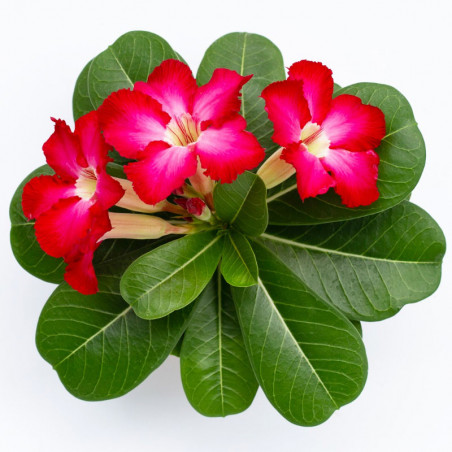






The desert rose (Adenium obesum) is a perennial succulent shrub with attractive flowers and a large trunk. It is native to Africa and Asia and can be grown both indoors and outdoors. This plant reaches a height of between 1 and 2 meters and a diameter of 15 to 30 cm. It has smooth, grayish bark and a crown of opposite, lanceolate, dark green leaves. The flowers, in shades of red or pink, appear in clusters at the top of the plant.
Adenium obesum, commonly known as desert rose, is a perennial succulent shrub characterized by its striking flowers and thick, swollen trunk, giving it a unique and ornamental appearance. It is native to the arid regions of Africa and Asia, particularly areas like Arabia and the Horn of Africa, where it grows naturally in hot, dry environments. Despite its origin in arid climates, this plant is highly valued in gardening due to its adaptability, allowing it to be cultivated both indoors and outdoors, provided the right conditions of light and temperature are met.
Adenium obesum can reach a height of between 1 and 2 meters, with a diameter ranging from 15 to 30 cm. Its thick trunk, bulbous at the base, stores water, enabling it to withstand periods of drought. The plant’s bark is smooth and grayish, while the leaves, dark green in color, are opposite, lanceolate, and fleshy in texture, typical of succulent plants. Flowering is one of the most notable features of this plant: its large and showy flowers can be red or pink, appearing in clusters at the top of the plant. These flowers have a tubular shape with petals that open in a circle, making them attractive to both gardeners and pollinators.
Cultivating desert rose requires a warm, sunny climate, as the plant does not tolerate frost well. It prefers well-drained soil and moderate watering, as excessive water can cause root rot. Although it is drought-tolerant, it is important not to neglect watering for extended periods, especially during hotter months. Regarding pruning, it is recommended to shape the plant and encourage better branching, particularly when grown in pots. Additionally, it can be cultivated as an ornamental plant in gardens, patios, or even indoors, provided it receives enough direct sunlight.

| January | February | March | April | May | June | July | August | September | October | November | December |
Data sheet
No customer questions for the moment.